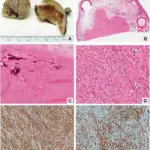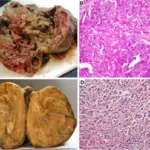Fibrothecomas are a spectrum of benign sex cord–stromal tumors composed of fibroblastic stromal cells and/or luteinized theca-like cells. When both cell types are present in a tumor, it is typically classified as fibrothecoma.
What is the Pathology of Fibrothecomas?
The pathology of fibrothecomas is:
-Etiology: The cause of fibrothecomas is mass effect causing compression on different organs.
-Genes involved: None.
-Pathogenesis: The sequence of events that lead to fibrothecomas.
-Morphology: The morphology associated with fibrothecomas shows heterogeneous solid mass.
-Histology: The histology associated with fibrothecomas shows fibrous tissue.
How does Fibrothecomas Present?
Patients with fibrothecomas typically females at any age, but most commonly arise in middle-aged to postmenopausal women. The symptoms, features, and clinical findings associated with fibrothecomas include: menorrhagia, abdominal pain, pleural effusion, abdominal distention.
How is Fibrothecomas Diagnosed?
Fibrothecomas is diagnosed by ultrasound, CT scan, histological studies, and laparotomy.
How is Fibrothecomas Treated?
Fibrothecomas are treated by resection.
What is the Prognosis of Fibrothecomas?
The prognosis of fibrothecomas is unknown.



